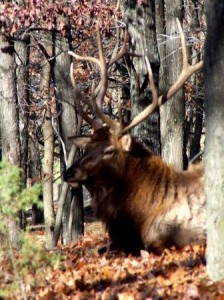
HARRISBURG – Year after year, Labor Day weekend kicks off a period of increased activity on Pennsylvania’s elk range.
As elk begin ramping up their routines ahead of peak bugling season, visitors flock in greater numbers to areas where they can see the wild spectacle unfold.
In a typical year, an estimated 75,000 to 100,000 people visit Elk County alone during the two-month span between Labor Day and Halloween.
But 2013 isn’t a typical year in regard to Pennsylvania’s elk. Rather, it’s an extraordinary one.
This year marks the 100th anniversary of efforts to restore elk to Pennsylvania, and in commemoration of that landmark anniversary, special events are planned each weekend through Columbus Day at sites on the elk range.
With the added attractions and excitement over the anniversary, it’s hard to say how many people might make Pennsylvania’s elk country a destination this year. But there seems this year to be even more of a buzz than usual surrounding bugling season, Pennsylvania Game Commission Executive Director Carl G. Roe said.
“If you’ve ever made a trip to the elk range in autumn and been a part of those enormous crowds, it’s hard to imagine you could add more excitement to the mix,” Roe said. “But that seems to be the case this year. With the anniversary going on, and events taking place each weekend, things are building to a fever pitch.”
Those who make weekend trips to the elk range this fall will have an opportunity to take part in several tours of state game lands in hopes of seeing elk or hearing them bugle. Some tours are by vehicle, while others are by bicycle and go farther off the beaten path. There’s also an elk-viewing hike set for Sept. 21.
Performances by Van Wagner, an award-winning educator and musician, tell the story of the elk’s comeback in Pennsylvania, and otherwise celebrate the state’s rural heritage.
The corral trap used in the Game Commission’s initiative to capture elk and expand the overall range of the herd will be on display through Columbus Day. And, as always, there’s something for everyone at the Elk Country Visitor Center near Benezette.
Different events are scheduled on different weekends, and at different times. For a full schedule of events, visit the homepage of the Game Commission’s Web site, www.pgc.state.pa.us and click on the button labeled “100th Anniversary PA Elk Restoration.”
Roe said that while those making the trip to the elk range this year will be treated to something extra with these events, the elk themselves remain the real attraction. There’s really nothing like the display of a bull elk moving in at close range and piercing the brisk morning air with a cloud of vapor and an ear-splitting bugle, he said.
With the herd now containing more than 850 animals living in parts of five northcentral Pennsylvania counties, there’s as broad a chance as ever for visitors to take in those sights and sounds.
It’s a remarkable contrast to the era of more than a century ago, when elk found themselves eliminated from their natural range in Pennsylvania and the rest of the Northeast, Roe said. That turnaround is a reason for celebration, he said.
“One hundred years later, there’s no arguing that elk restoration here in Pennsylvania has been about as successful as could possibly be expected,” Roe said. “It’s something every Pennsylvanian can be proud of.”
Elk in Pennsylvania
Historically, elk inhabited much of Pennsylvania. But as more of the state was settled, the elk population declined.
By the late 1800’s, Pennsylvania’s elk were eliminated from their last stronghold in areas around Elk County. And, by the time the Pennsylvania Game Commission launched an effort to reintroduce elk to Pennsylvania, the animals had been gone from the state for about 50 years.
Between 1913 and 1926, the Game Commission released 177 elk into Pennsylvania’s wilds. And, the elk that live here today are the progeny of those animals.
A three-year trap-and-transfer program launched by the Game Commission in 1998 expanded the elk’s range from 350 to 800 square miles, allowing the herd to grow. And aggressive management of habitat for elk also has helped to boost the number of elk, and steer elk into areas where they are less likely to have conflicts with people.
Today, Pennsylvania’s elk herd contains between 850 and 900 animals living in parts of Elk, Cameron, Clinton, Potter and Clearfield counties in the northcentral part of the state.
And, a century after the first reintroduction efforts began, the elk’s restoration represents one of the great successes in wildlife conservation history.